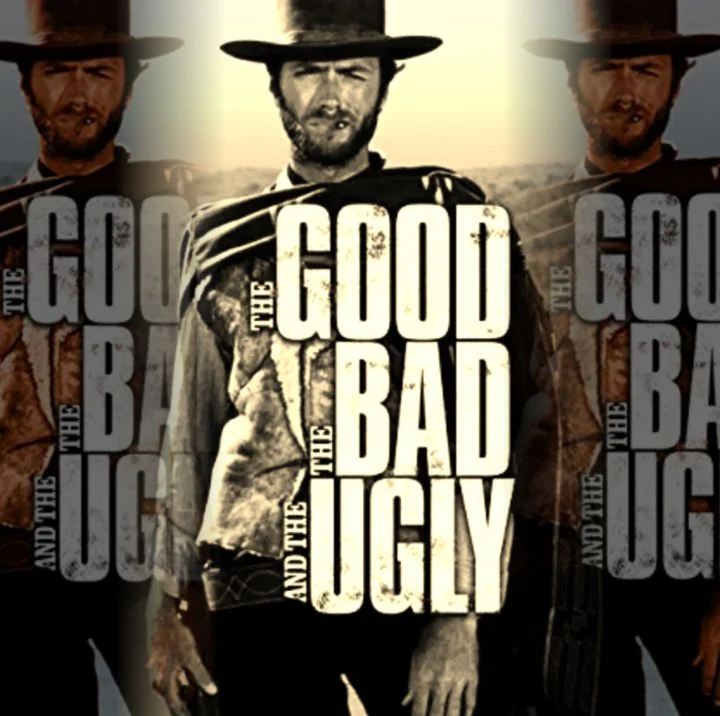
Movie Review - The Good, The Bad and The Ugly
"The Good, The Bad and The Ugly" is a classic spaghetti western film that was released in 1966. It is widely regarded as one of the best western movies ever made and has become an iconic part of popular culture. Directed by Sergio Leone, the film stars Clint Eastwood, Lee Van Cleef, and Eli Wallach in the leading roles. The movie was produced by Alberto Grimaldi and Leone, and was shot in Spain and Italy.
The film's plot revolves around three gunslingers who are all in search of a fortune in buried Confederate gold during the American Civil War. Clint Eastwood plays the role of "The Good," a bounty hunter named Blondie who is pragmatic and cunning. Lee Van Cleef plays "The Bad," a ruthless outlaw named Angel Eyes who is determined to get his hands on the gold. Eli Wallach plays "The Ugly," a Mexican bandit named Tuco who is crafty and opportunistic.
The story begins with Blondie and Tuco working together to scam townsfolk out of rewards for wanted criminals. However, their partnership is short-lived as Blondie decides to abandon Tuco in the middle of the desert. Tuco eventually catches up with Blondie, and the two end up teaming up again to find the hidden gold. Angel Eyes, who is also on the hunt for the treasure, joins the two men on their quest. The film's final act takes place in a cemetery where the three characters engage in a tense standoff that will determine who walks away with the fortune.
"The Good, The Bad and The Ugly" is an exceptional film that succeeds on several levels. Firstly, the performances of the lead actors are outstanding. Clint Eastwood's portrayal of Blondie is a masterclass in understated acting, with his steely gaze and laconic delivery creating a memorable character that would become a pop culture icon. Eli Wallach's Tuco is a larger-than-life figure who is both comical and menacing, while Lee Van Cleef's Angel Eyes is a cold and calculating villain who is impossible to take your eyes off.
Another aspect of the film that stands out is its production values. The movie was shot on a relatively low budget, but Leone's vision and attention to detail make it look much more expensive than it was. The film's cinematography is breathtaking, with the Spanish and Italian landscapes providing a stunning backdrop for the action. The use of extreme close-ups, long shots, and tight framing create a sense of tension and drama that is rarely seen in modern cinema.
The film's soundtrack, composed by Ennio Morricone, is also a standout feature. The haunting melody of the main theme, which features whistles, guitars, and bells, has become synonymous with the genre and is instantly recognizable. The soundtrack perfectly complements the film's visuals, enhancing the tension and drama on screen.
One of the reasons why "The Good, The Bad and The Ugly" has stood the test of time is its themes. The movie is essentially a commentary on the nature of greed and the human condition. The characters are all motivated by their desire for the gold, and the lengths they will go to acquire it are extreme. The film's anti-heroic characters are complex and morally ambiguous, which makes them more interesting and relatable than the typical cowboy hero. The movie's portrayal of the American Civil War as a brutal and senseless conflict is also noteworthy, as it eschews the usual romanticized depiction of the era.
In terms of its rating, "The Good, The Bad and The Ugly" was originally rated R in the US due to its violent content. However, the film has since been re-rated to a PG-13, which means that it is suitable for audiences aged 13 and above.
One of the most striking features of the movie is its pacing. At nearly three hours long, the film is a slow burn that gradually builds to its climactic finale. The pacing is deliberate, with Leone taking his time to develop the characters and their motivations. The result is a film that feels like an epic journey, with the audience invested in the outcome of the characters' quest.
Another aspect of the movie that stands out is its use of humor. Despite the film's serious subject matter, there are several comedic moments that lighten the mood. Eli Wallach's Tuco is particularly adept at delivering witty one-liners and physical comedy, which adds a layer of levity to the movie.
The film's legacy has extended far beyond the world of cinema. The iconic score and imagery have been referenced in countless movies, TV shows, and music videos. The movie has also inspired several video games, including "Red Dead Redemption" and "Call of Juarez."
In terms of its critical reception, "The Good, The Bad and The Ugly" has been universally praised. It currently holds a 97% approval rating on Rotten Tomatoes, with critics praising its visuals, performances, and themes. The movie has also been recognized with several awards, including a BAFTA for Best Film Music and a National Board of Review Award for Best Supporting Actor (Lee Van Cleef).
Summarily, "The Good, The Bad and The Ugly" is a masterpiece of cinema that has stood the test of time. The film's iconic characters, stunning visuals, and memorable soundtrack have made it a beloved classic that continues to inspire filmmakers to this day. Sergio Leone's vision and attention to detail, coupled with the outstanding performances of Clint Eastwood, Eli Wallach, and Lee Van Cleef, make this movie an unforgettable cinematic experience that should be seen by all fans of the western genre.

Comments
Share Your Thoughts